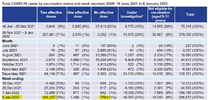The AusVaxSafety data also shows that 1.1% of Covid-19 doses (vs Influenza 0.3%) results in the person seeking a GP or ER/Hospital/medical attention (I believe within 0-3 days) ... which further demonstrates that 0.06% Switzerland statistic to be misleading.
Do you not think that people are possibly hypersensitive to any sort of reaction to the covid vaccine given the situation we are in and the chatter associated, leading them to react more to an adverse reaction that they would normally brush off with a flu vaccine?







